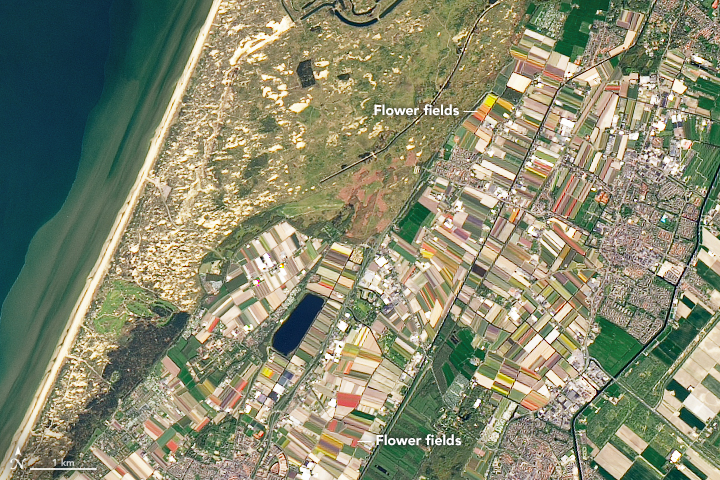

Flower Power in the Netherlands
Downloads
- netherlands_oli_2018111_lrg.jpg (5362x3575, JPEG)
- netherlands_oli_2018127_lrg.jpg (5362x3575, JPEG)
Metadata
- Sensor(s):
- Landsat 8 - OLI
- Data Date: April 21, 2018 - May 7, 2018
- Visualization Date: May 11, 2018
Every year, seven million flower bulbs are planted in Keukenhof Garden in the Netherlands. When the final winter chill disappears and springtime arrives, the bulbs sprout to produce beautiful rows of reds, oranges, and yellows—including 800 varieties of tulips.
The season begins in March with purple crocuses, followed by hyacinths and daffodils. It ends with tulips reaching peak bloom in April. The vivid display draws more than a million tourists, who line up for a glance before the flowers are harvested and disappear.
The colorful floral spectrum can also be seen from space. The Operational Land Imager (OLI) on Landsat 8 captured the scene on April 21, 2018. The second image, acquired on May 7, shows the same area after many flowers were harvested.
The landscape in these images—known as the “bulb region”—lies about 20 kilometers (12 miles) from Amsterdam. It contains numerous gardens, including Keukenhof, one of the world’s largest flower gardens. The Netherlands is the largest producer of tulip bulbs in the world, providing 4.2 billion annually and exporting half.
References and Further Reading
- Dutch Review (2018, March 10) A guide to the tulips season in Holland. Accessed May 11, 2018.
- Keukenhof Holland What is Keukenhof?" Accessed May 11, 2018.
- NASA Earth Observatory (2017, August 18) Tulip Mania.
- NL Times (2017, May 24) Record Year for Flowers: 1.4 Mil Visit Keukenhof; 550,000 Flowers in Amsterdam Tulip Festival. Accessed May 11, 2018.
- The Washington Post (2018, April 19) A sure sign that spring is here: Netherlands tulip farms are striped with color. Accessed May 11, 2018.
NASA Earth Observatory images by Joshua Stevens, using Landsat data from the U.S. Geological Survey. Story by Kasha Patel.
This image record originally appeared on the Earth Observatory. Click here to view the full, original record.